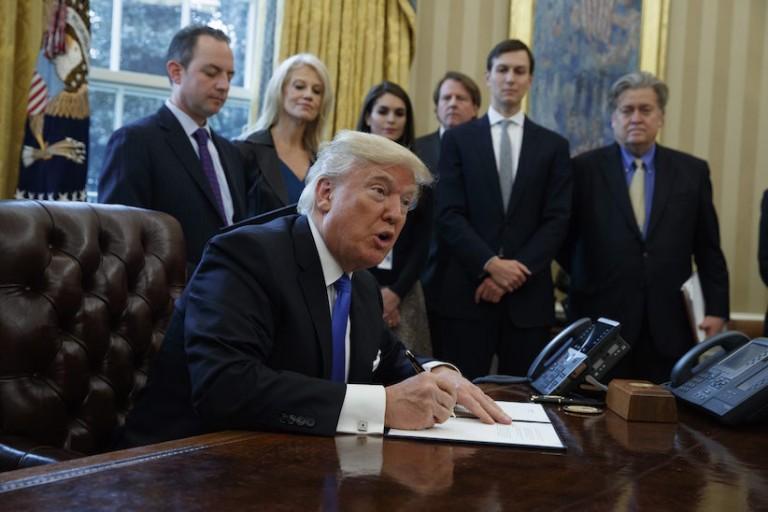Trump’s bulldozer diplomacy meets pipeline politics
Donald Trump has ordered the fast-tracking of the Keystone XL pipeline—charging into Canada’s delicate dance with those opposed

President Donald Trump signs an executive order on the Keystone XL pipeline, Tuesday, Jan. 24, 2017, in the Oval Office of the White House in Washington. (AP Photo/Evan Vucci)
Share
When the Trudeau government gave the thumbs-up in November to Enbridge’s Line 3 pipeline replacement and Kinder Morgan’s Trans Mountain expansion, pretty much every politician, journalist and other observer noted the wide distance between an approved pipeline project and a built pipeline project; on the road from there to here sit the complexities of investment deals, negotiations with First Nations groups, legal hurdles and protests. There were fewer utterances about that long and sometimes sinkhole-marked road (remember the formerly approved Northern Gateway?) when Donald Trump signed presidential memos Tuesday to revive and fast-track the Keystone XL pipeline and the Dakota Access line, except in news stories referring to the furious reaction from environmental and Indigenous groups.
A couple important reasons lie behind this difference between a Trudeau OK and a Trump OK. The big one is patience: Trudeau extended the process for the Vancouver harbour-bound Trans Mountain, in hopes a new layer of consultation would bring more buy-in or make it look like a new Liberal government was trying harder to care. Trump’s first-week edict gives Secretary of State Rex Tillerson (the former Exxon-Mobil chief) a mere 60 days to permit a new Keystone application from Calgary-based TransCanada, and there’s a similar haste now behind the Dakota project, whose mass on-site protests prompted the Obama administration to pause the project for more assessment.
Beyond patience, the approving leaders’ different personalities are a distinguishing factor. Whatever substance there was behind Trudeau’s assertion that “communities give permission” for energy projects, he wound up signalling that he’d direct at least pouted empathy toward pipeline critics. His message of the economy and environment strolling hand-in-hand has come with pledges of a carbon tax and a thicket of marine protections and National Energy Board conditions for pipeline builders to meet. Not so for Trump. Stubborn defiance seems his default campaign mode, and environmental considerations are the straitjackets of job growth; let’s expect him to put more heft behind these projects, and find bulldozers to clear protesters so corporate bulldozers can move earth. A transition official, chatting with a Maclean’s source, wasn’t talking about negotiations with Sioux reserves or concessions or talks with environmental groups. “We’re trying to minimize the number of casualties,” the Trump associate said, according to the source.
Consider last month, when Natural Resources Minister Jim Carr spoke of the military responding to non-peaceful protest, and then quickly backed off and said the Liberal government “embraces” dissent. Trump, meanwhile, is the leader who reportedly praised the blood-in-the-streets manner with which Philippines President Rodrigo Duterte has dealt with local drug crime. Gulp. Our guess is as good as yours on what happens when a protester chains herself to a fence of a project where Trump wants to host a ribbon-cutting.
There were thousands camped out last fall in chilly North Dakota as Standing Rock “water protectors.” And that was when Barack Obama still lived and worked in the White House. Now, there’s a rapid-mobilization movement of many more that gathered in cities in United States, Canada and abroad to protest Trump’s attitude toward women and his presidency. Various groups are calling themselves “the Resistance” against Trump. Parts of it could well coalesce around Dakota and Keystone construction sites, now that they can depict Trump as the figurehead of these projects. “Resistance” has already been a big word around those projects. “Unwittingly he is beginning to build a wall, a wall of resistance,” Michael Brune, executive director of the Sierra Club, told the Associated Press. “This fight is far from over.”
“These attacks will not be ignored, our resistance is stronger now than ever before and we are prepared to push back at any reckless decision made by this administration,” said a statement from the Indigenous Environment Network. “If Trump does not pull back from implementing these orders, it will only result in more massive mobilization and civil disobedience on a scale never seen of a newly seated president of the United States.”
Trudeau and his cabinet, along with premiers Rachel Notley and Brad Wall, all hailed the jobs and prosperity Keystone XL will bring to Canada and beleaguered Alberta. There’s a danger they’ll be forced into pursed lips and frets if an increased urgency among pipeline protesters collides violently with an increasingly urgent pro-jobs U.S. president who’s not good at brooking dissent. By the time Kinder Morgan begins pipeline construction (as soon as this fall) and protesters may bid to peacefully block it in B.C.’s Lower Mainland, the fear of a spill or carbon emissions may not be the big ugly things the public associates with pipeline projects.